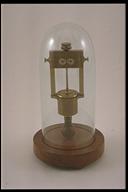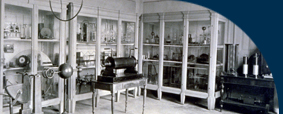|
OUR COLLECTION OF SCIENTIFIC INSTRUMENTS
ACOUSTICS |

 |
Cagniard de la Tour's siren |
 |
Sirena di Cagniard de la Tour |
| Subjects: acoustics/sound frequency |
Settore: acustica/misuratore di frequenza sonora |
| Inventory Number: 16 |
Numero di inventario: 16 |
| Secretan à Paris [document] |
Secretan à Paris [documento] |
| 1862 [document] |
Periodo di costruzione: 1862 [documento] |
| Brass, mahogany, steel, glass |
Materiali utilizzati: Ottone, mogano, acciaio, vetro |
| 75 X 55 X 190 [mm] |
Dimensioni: 75 X 55 X 190 [mm] |
| |
|
This device permits the production of a sound and the determination of its level through the measurement of the absolute frequency. It was described for the first time by the French physician Charles Cagniard de la Tour (1779-1859) in an article published in the "Annales de Chimie et de Physique" of 1819. The following year the article was translated into English in the "Philosophical Magazine". Cagniard justified the name of this device by saying: si l'on fait passer de l'eau dans la sirène, au lieu d'air, elle produit ègalement le son, lors même qu'elle est entièrement immergée dans ce fluide, et les memes nombres de chocs produisent les memes notes que par l'air. C'est à cause de cette propriété d'être sonore dans l'eau, que j'ai cru pouvoir lui donner le nom sous lequel elle est désignée . [If you make some water pass through the siren, instead of introducing air, it produces sound all the same, even when it is completely dipped into water, and the same number of impacts produces the same notes that would be produced by air: it is because of this capability to produce sound in the water that I thought it was possible to call it by that name.] |
Questo apparato permette di produrre un suono e di determinarne l'altezza tramite la misura della sua frequenza assoluta. Esso fu descritto per la prima volta dal fisico francese Charles Cagniard de la Tour (1779-1859) in un articolo apparso negli "Annales de Chimie et de Physique" del 1819. L'anno successivo, l'articolo fu tradotto in inglese nel "Philosophical magazine". Cagniard motivò così il nome dell'apparato: si l'on fait passer de l'eau dans la sirène, au lieu d'air, elle produit également le son, lors même qu'elle est entièrement immergée dans ce fluide, et les mêmes nombres de chocs produisent les mêmes notes que par l'air. C'est à cause de cette propriété d'être sonore dans l'eau, que j'ai cru pouvoir lui donner le nom sous lequel elle est désignée. |
| |
|
Description: The brass siren is fixed into a circular mahogany base and it is protected by a glass bell. It consists of a cylindrical box with an opening that can be placed on the case of the bellows and that blows continuous air current inside it. The upper base of the box has on its surface 20 equidistant holes arrayed in a ring; upon the box is a disk, having the same number of holes of the same dimensions and ordered in the same manner, which can rotate freely around a vertical steel coaxial axis. Both series of holes are cut aslant in the opposite direction so that when air comes out of the lower hole it hits the wall of the upper hole and causing a series of impulses that trigger the rapid rotation of the disk and of the axis; at the same time air comes out intermittently through the alternated opening and closing of the holes, it therefore vibrates and produces a sound that becomes increasin more acute with the increase in air pressure and, consequently, in the rotation speed. Its height, which is psychically perceived by the number of vibrations hitting our ears [1], can be obtained multiplying the number of the disk's holes by the number of rotations it makes in a given unit of time. The unit of time is recorded through a wormscrew with a revolution-counter set in motion by the axis of the disk itself. The wormscrew meshes with a gear wheel with fifty cogs that turns one cog for every single revolution of the disk, thereby making an index turn on a circular steel quadrant, in which there is a carved circular scale with fifty marks. |
Descrizione: la sirena, interamente d'ottone, è fissata su una base circolare in mogano ed è protetta da una campana di vetro. Essa è costituita da una scatola cilindrica munita inferiormente di un'imboccatura che si adatta sopra la cassa di un mantice e che provvede a soffiarvi dentro una corrente continua d'aria. La base superiore della scatola porta sulla sua superficie una corona di 20 fori equidistanti; su di essa pu ruotare liberament attorno ad un asse coassiale verticale d'acciaio, un disco attraversato da un'altra corona di fori perfettamente corrispondenti in numero, disposizioni e dimensioni a quelli sottostanti. I due ordini di fori sono tagliati obliquamente in senso inverso in modo tale che l'aria, uscendo dal foro inferiore, urti contro le pareti del foro superiore e vi imprima una successione di impulsi che producono la rapida rotazione del disco e dell'asse; contemporaneamente l'aria, uscendo con intermittenza per l'alternativa interruzione dell'apertura e chiusura dei fori, vibra e produce un suono che diviene sempre pi acuto con l'aumento della pressione dell'aria, e quindi della velocità di rotazione. La sua altezza, percepita dal numero di vibrazioni al secondo che giungono all'orecchio [1], si ottiene moltiplicando il numero dei fori del disco per il numero dei giri che esso fa nell'unità di tempo. Quest'ultimo viene registrato, per mezzo di un contagiri messo in funzione dall'asse medesimo del disco, mediante una vite perpetua. Questa ingrana su una ruota dentata che ha cinquanta denti e che gira per un dente ad ogni rivolgimento del disco, facendo muovere un indice su un quadrante circolare d'acciaio, avente incisa una scala circolare di cinquanta tacche. |
| |
|
Functioning: To determine the height of an external sound the siren is set into motion with an increasing velocity, therefore, obtaining an increasingly acute sound until you hear one sound that has the same level as the first one, that is, until the two sounds are unisonous. At that moment you read the speed of the rotation of the siren's disk and make a calculation to obtain the number of vibrations that are needed. |
Funzionamento: per determinare con buona approssimazione l'altezza di un suono esterno, si mette in moto la sirena ad una velocità sempre crescente e si ottiene cos un suono sempre più acuto finché, con l'orecchio si giudica che esso abbia la medesima altezza di quello dato, cioè che i due suoni siano all'unisono; in quel momento si legge la velocità di rotazione del disco della sirena e si procede al calcolo per ottenere il numero cercato di vibrazioni. |
|
|
|

